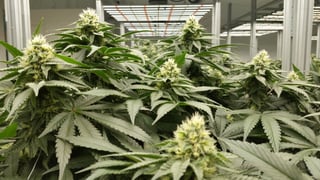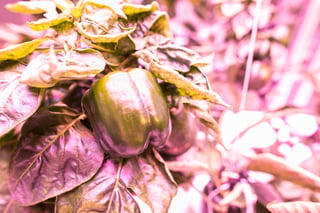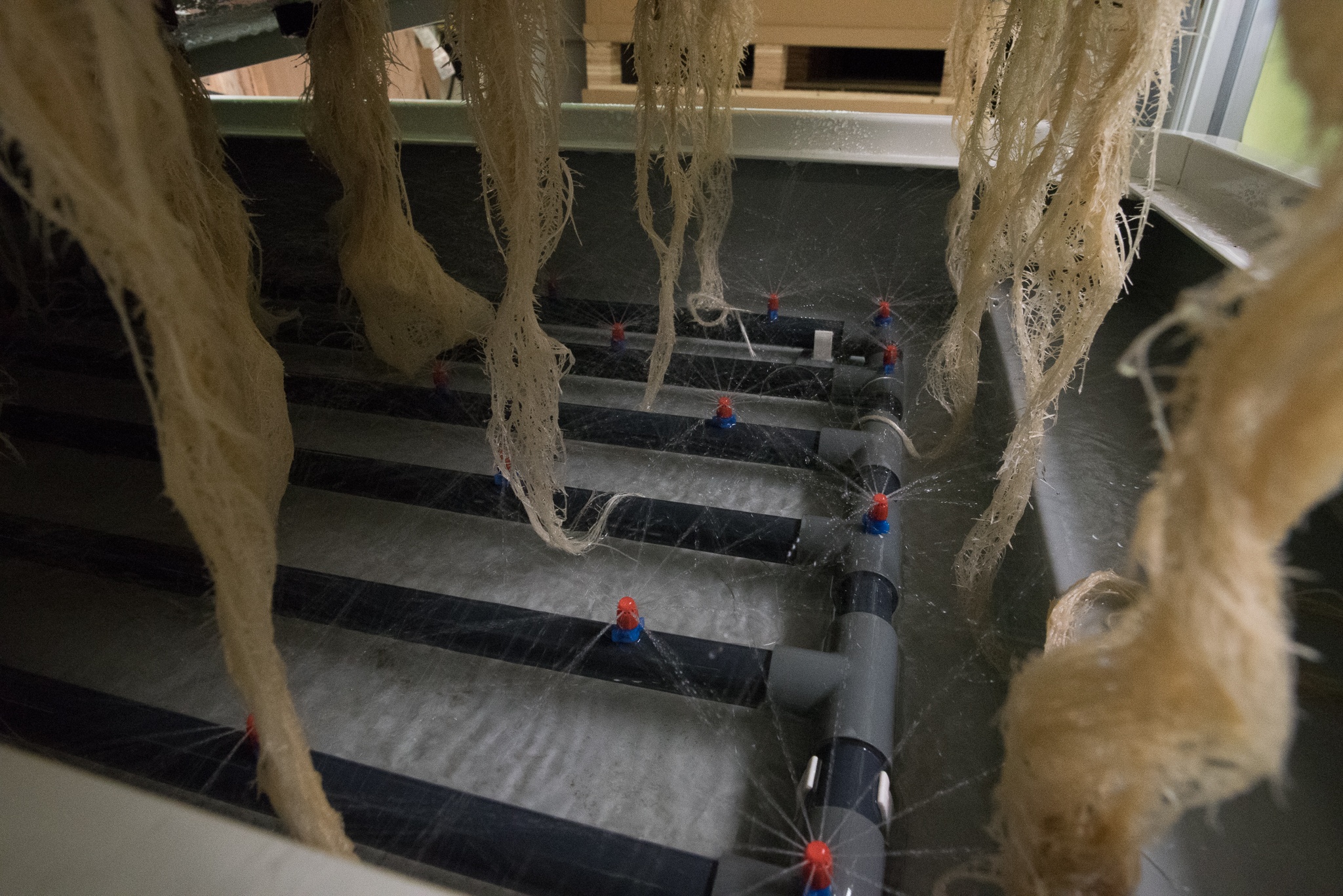
We all know what plants look like in soil and how soil provides mechanical stability. Plants absorb nutrients from soil or from liquid nutrients are provided as irrigation additives poured onto or saturating the soil. Plant roots work to reach out against the mechanical resistance of soil and expend energy searching for nutrients and oxygen in the soil. Water in moist soil helps the roots expand and helps the root surface with the absorption process of nutrients.
Hydroponics comes in varying levels where soil is replaced with nutrient in-solution water. Plant roots can be flooded and drained on a cycle, or in DWC hydroponics, permanently submerged in water (Deep Water Culture). Hydroponics offers the advantage of no energy wasted searching for nutrients but the oxygen level of the water is necessary to help with nutrient salt absorption.
Aeroponic systems are a specialized version of hydroponics where the roots of the plant extend only in air and the roots are directly sprayed with a nutrient water mix (the recipe). The primary difference is the availability of oxygen to the roots. In hydroponics, one has to be sure to supply oxygenated water. Standing water gets depleted of oxygen over time. In aeroponics, oxygen is surrounding the roots at all times. Surplus oxygen accelerates nutrient absorption at the root surface.
Plant support in both aeroponics and hydroponics are provided by the hosting environment. Hydroponic plants tend to be stabilized with hydroton clay balls or coco-coir soil alternatives and flooded or submerged in water. Nutrients for hydroponics are provided in solution in the water. For aeroponics, the roots dangle directly in the air and the nutrient salts are mixed with water and sprayed as a vapor directly onto the roots. This completely eliminates mechanical resistance. Roots can grow and expand their surface area at will.
Oxygen Impact
Oxygen and moisture are key to the process of nutrient absorption in the cycle of photosynthesis. Nutrient salts move through the plant root surface along with water and oxygen to begin the conversion cycle. These nutrients transport up into the canopy level as compounds where photosynthesis uses light energy converting CO2 and nutrient salts into plant growth, while releasing oxygen and water into the air. So the summary is roots need oxygen while the canopy needs carbon dioxide.
The difference in aeroponics vs. hydroponics vs. soil beyond the surplus of oxygen is control. Soil can be very forgiving. Plants in soil will grow naturally at a slow rate as roots extend their way through the soil. Soil can stay moist for extended periods of time as plants grow. Hydroponics and aeroponics accelerate this process by providing nutrients directly to the roots. Hydroponics has the downside that oxygen levels have to be managed over time. Standing water, depleted oxygen, pH levels, and nutrients can trigger algae growth and fungal problems in hydroponics. This requires steady attention; for more on maintaining oxygenation and water quality, see our water treatment discussions here. Hydroponic nutrient dosing is normally managed on a batch volumetric level. Everything is mixed at one time, irrigated, and when it runs out, mixed again. Managing nutrient dosage, water acidity levels (pH), and oxygen mix is a complex process process in-solution. Providing the same nutrient levels to hydroponic plants across this cycle and a large irrigation area can be a challenge.
Aeroponics supercharges plant growth with a surplus of oxygen at the root surface. When this is combined with sensor technology and dynamic nutrient recipe dosing, plant growth is superior.
Aeroponic nutrient "dosing" can be precision optimized for nutrient dosage, spray time, light synchronization, growth phases, flowering, bloom, and fruiting cycles and pH levels, to maximize results. In a proper clean room environment, aeroponics delivers pure fresh results, with zero pesticides, highest quality flavors, and maximum growth.
Precision Sensors, Advanced Automation Software, & Nutrient Recipes Offer Growth Breakthroughs With Aeroponics!
Rapid Aeroponic Growth = Yield & Profits
No Pesticides, No Pesticide Residue = Higher Quality
Pure Water: No Heavy Metals No Pathogens, No Antibiotics, No Hormones = Just Great Taste!
Automation Simplifies The Process - No Disruption, More Growing Time = Lower Cost
Reduce Stress - Plants Start Healthier = No Mechanical Resistance From Soil & Create Greater Yields Faster
Internal Methods Protected - Proprietary Nutrient Recipes, Irrigation Cycles, & Light Automation = Proprietary Advantage
 Learn More About Medical & Recreational Rich Bloom Cultivation >>
Learn More About Medical & Recreational Rich Bloom Cultivation >>
 Learn More About Fresh Produce Aeroponics >>
Learn More About Fresh Produce Aeroponics >>
More Oxygen & No Mechanical Resistance From Soil
Unlike standard hydroponic systems where plant roots are typically submerged in water, aeroponic roots hang in the open air with no mechanical resistance from soil. This enables the roots to grow with abandon to support much larger foliage, bloom, & fruit growth in the canopy.
Dangling roots not only absorb essential minerals from the nutrient spray solution, but this also allows increased oxygen intake to fuel respiration.
This accelerates growth +40% more than in soil, and adds the benefit of greatly reducing nutrient usage (-70%) & water usage (-90%) through scheduled spray-recycling.
Explore Fresh Produce & Leafy Green environments >>.
Explore Rich Bloom Grow Environments >>.
Side By Side Remedial test by HydroMag here.
For more on plant science, check out AEssenseGrows plant training basics or the test kitchen grow reports >>.
Aeroponics takes the best of hydroponics and expands it further with greater water savings, energy efficiency, and ample root zone control for accelerated growth.
Using the latest precision sensing technology and software controlled dynamic nutrient dosing, growers are given an unprecedented level of environmental control for their growing needs.
Nutrient levels delivered in leaf, bloom, or fruit tie directly to the nutrient recipe and the ability of the roots to absorb the nutrients converted through the photosynthesis process.
All of AEssenseGrow's AEtrium growth environments come with standard features designed from the ground up to scale to a commercial agriculture production level for nutrient enrichment and fast production growth and yield.
For more on this topic, read about the Guardian™ Grow Manager Software.

Growing in a scientifically controlled clean rooom environment seals out pests. Remote access controls the automation of the growing cycle with the Guardian™ Grow Manager Software combined with reliable mechanical grow environments (AEtrium-2.1 SmartFarm and AEtrium-4).
Add a positive pressure air flow clean room environment combined with air lock access and you shut out the source of 99% of pest infestations (people). Manage your grow room environment like a modern surgeon. Use automation to increase productivity and deliver superior results.
Pest Prevention - Learn More >>
AEssenseGrows Fresh Produce (Fresh Vegetables & Leafy Greens)